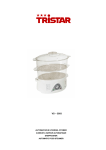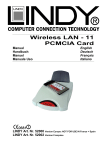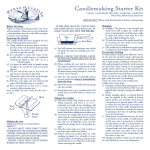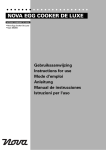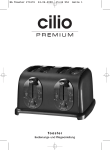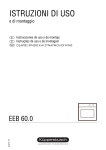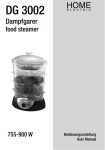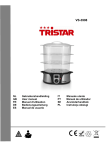Download Petra EA 20
Transcript
Petra_262028 26-02-2013 17:53 Pagina 1 Instructions for use Mode d’emploi Anleitung Istruzioni d’uso TYPE 262028 EIERKOCHER & DAMPFGARER EA 20 Petra_262028 26-02-2013 17:53 Pagina 2 2 Petra_262028 26-02-2013 UK 17:53 Pagina 3 Instructions for use . . . . . . . . . . . . . . . . . . . . . . . . . . . . . . . . . . . 4 F Mode d’emploi D Anleitung I Istruzioni d’uso . . . . . . . . . . . . . . . . . . . . . . . . . . . . . . . . . . . . . . 18 ....................................... ............................................ 3 9 13 Petra_262028 26-02-2013 17:53 Pagina 4 PETRA EIERKOCHER & DAMPFGARER EA 20 ART. 262028 Read these instructions thoroughly first and keep them for future reference. Check that the voltage in the house is the same as that of the appliance which must be connected to an earthed socket. DESCRIPTION 1. Lid 2. Steam plate 3. Egg rack 4. Base with hotplate 5. Measuring cup 6. Rice container 7. 2 egg trays 8. OFF switch 9. ON switch with indicator light The PETRA EIERKOCHER & DAMPFGARER EA 20 is finished in brushed stainless steel. This fully automatic egg cooker with steamer function is suitable for boiling up to 6 eggs at once. When the food is ready the built-in buzzer will sound to indicate this. The egg cooker with steamer function has an on switch with indicator light, an off switch, an egg rack, a steam plate, a transparent lid, 2 egg trays, a rice container, and a measuring cup. USING THE EGG COOKER Prick a hole in the rounded ends of the eggs to be boiled. This stops the eggs from cracking. Fill the measuring cup with water up to the mark for the number of eggs you are boiling. Also allow for the hardness of the eggs (see the measuring cup). Pour the water on to the egg cooker hotplate. Note: the scale is for medium size eggs. If you want the eggs to be a little harder add a little more water. Use a little less water for softer eggs. Experiment until you have found the ideal quantity of water for yourself. Put the egg rack on the bottom of the egg cooker. Put the eggs in the egg rack and then put the transparent lid on the appliance. The lid has holes to allow the steam produced while boiling to escape. Make sure these holes are kept uncovered! Put the plug in the socket and switch on the appliance using the on/off switch. The buzzer will sound when all the water has evaporated. Switch the appliance off again. Take the lid off the appliance (N.B.: the lid will be hot!). Remove the eggs still in the rack using the handles and cool them rapidly in cold water. Note: let the appliance cool down for 15 minutes before using it again. USING THE STEAMER FUNCTION This appliance is not only ideal for boiling eggs but also for steaming foods. Many variations are possible. 1. Use the measuring cup to pour water onto the hotplate. 2. Place the egg rack and the steam plate onto the metal container. Position the steam plate in the centre of the egg rack so it can’t become dislodged. 3. Place the food you wish to steam onto the steam plate. 4. Put the transparent lid on the appliance. Please note: if the food is moist the dish may become watery. Ensure that the food does not touch the lid. If you follow these instructions your food will be steamed perfectly. USING THE RICE COOKER This appliance also has a special rice cooking function. It can be used to serve delicious steamed rice. 1. Put cleaned rice in rice container. Add water to about 5mm above the rice, and leave to soak for around 15 mins 2. Add a cup (hard 3 mark) of water to water reservoir. Attach egg rack 3. Attach the rice container to egg rack and close the lid 4. Insert the plug into the socket and turn on the appliance by pressing ON/OFF switch. Turn off the appliance when the buzzer sounds. You can now serve the rice. Note: Certain types of rice may need a longer cooking time. Let the appliance cool down for 15 minutes before using it again. 4 Petra_262028 26-02-2013 17:53 Pagina 5 Tips for using the mini steam cooker One of the features of this device is that when steaming the volume of water may need to be increased. Never add more water than the hard 1 mark on the measuring cup. - When using the steamer with frozen goods, the cooking times may vary depending on the amount of water that comes out of the food. Also, please note that steaming times may vary depending on the volume of food in the steamer. - When the volume of food is small, increase the amount of water 1-2 gradations above the recommended amount. - After cooking, first wait for 15 minutes before you begin cooking again. - If you stop steaming before cooking has finished, turn the power off, and wait for the steam to settle down before opening the lid. Be careful, the lid can be very hot. COOKING GUIDELINES FOR THE STEAMER Item Weight per item (g) Number Large pieces of meat About 135g Medium pieces of meat About 65g Small pieces of meat About 35g Dim sum About 25g Please use cooked noodles and dim sum. 2 2 3 8 Volume of water (chilled) Hard 1 Hard 6- medium 2 Medium 2 Hard 6- medium 2 Volume of water (frozen) n/a Hard 1- Hard 2 Hard 3- Hard 4 Hard 5- Hard 6 CLEANING FIRST UNPLUG THE CORD FROM THE SOCKET! The outside of the base can be cleaned with a damp cloth (never immerse it in water or other liquid). The separate parts can also be wiped clean with a damp cloth. If necessary these can also be cleaned in soapy water. Remove any scale from the hotplate after each use. If the chalky deposits become worse the hotplate can be cleaned using a mixture of 50% water and 50% vinegar. When doing this do not put the egg rack and the lid on the appliance. Plug the appliance in and boil the mixture for a few minutes. Repeat this a few times. Then clean the hotplate thoroughly with water. PETRA TIPS - Never immerse the base of the appliance in water or any other liquid. Always unplug the appliance before cleaning or if any fault develops. Never cover the steam holes in the lid. Remember that there will be steam underneath the lid which will escape through the openings. The lid gets very hot during steaming. Do not open the lid until you have finished. Always switch off the appliance when the buzzer sounds. If you leave the buzzer on for too long, it may become damaged. Make sure the appliance has completely cooled down before moving it. Leave the appliance to cool down for 15 minutes before re-using. The inside edge and the various parts become very hot. Ensure that children cannot reach it and be careful yourself. Ensure that the appliance is not so close to the edge of a table, working top, etc., that someone could knock it over. Do not allow the cord to hang over the edge or on the floor, as someone may become entangled or trip over it. Do not use the appliance if it is damaged or if the cable is damaged. Instead, send it to our service department. Do not place the appliance on or directly adjacent to a warm hotplate or other source of heat. The appliance must be connected to an earthed socket. This appliance is intended for normal household use only. Children should be supervised to ensure that they do not play with the appliance. This appliance can be used by children aged from 8 years and above if they have been given supervision or instruction concerning use of the appliance in a safe way and if they understand the hazards involved. Cleaning and user maintenance shall not be made by children unless they are older than 8 and supervised. Keep the appliance and its cord out of reach of children aged less than 8 years. 5 Petra_262028 26-02-2013 17:53 Pagina 6 - Appliance can be used by persons with reduced physical, sensory or mental capabilities or lack of experience and knowledge if they have been given supervision or instruction concerning use of the appliance in a safe way and understand the hazards involved. U.K. WIRING INSTRUCTIONS The wires in the mains lead are coloured in accordance with the following code: BLUE NEUTRAL BROWN LIVE GREEN/YELLOW EARTH As the colours of the wire in the mains lead of this appliance may not correspond with the colour markings identifying the terminals on your plug, proceed as follows: The wire which is coloured BLUE must be connected to the terminal which is marked with the letter N or coloured black. The wire which is coloured BROWN must be connected to the terminal which is marked with the letter L or coloured red. The wire which is coloured GREEN/YELLOW must be connected to the terminal which is marked with the letter E or and is coloured GREEN or GREEN/YELLOW With this appliance, if a 13 amp plug is used a 3 amp fuse should be fitted. If any other type of plug is used a 15 amp fuse must be fitted either in the plug or at the distribution board. WARNING: THIS APPLIANCE MUST BE EARTHED RECIPES STEAMED “POACHED” EGG, SAUSAGE AND ASPARAGUS (1 PORTION) 1 egg (broken into the foil case) 1-2 sticks of asparagus 2-3 hotdog sausages Salt and pepper to taste Method 1. Transfer the egg to the foil case. Add salt and pepper to taste. 2. Cut the asparagus into bite size pieces. Cut into the sides of the sausage (without cutting right through) if desired. 3. Using a measuring cup, pour water into the metal plate to medium 4 or 5. Put the egg rack and the steam plate in position; place the egg, asparagus and sausage on top, but not too close to the sides. 4. Close the lid tightly and turn the switch to the ON position. 5. As soon as the buzzer sounds, immediately turn the switch to the OFF position. When the steam has settled down, remove the lid. 6. The dish is ready to serve. STEAMED BROCCOLI WITH OLIVE OIL AND PARMESAN 170g broccoli (1 large bunch), tough stems discarded 2 teaspoons extra-virgin olive oil 10g finely grated Parmigiano-Reggiano (3 tablespoons) Cut broccoli into 4-5 cm wide florets. Peel stem and cut lengthwise into 1 cm wide sticks. Use the measuring cup to pour water into the metal container to medium 4 or 5. Steam broccoli on the steam plate until tender for 5 to 6 minutes. Transfer to a bowl and toss with oil, cheese, and salt and pepper to taste. 6 Petra_262028 26-02-2013 17:53 Pagina 7 ASPARAGUS WITH TARRAGON SHERRY VINAIGRETTE 175g medium asparagus, trimmed (1 to 2) 1 teaspoon Sherry vinegar 1/2 teaspoon minced shallot 1 small dollop Dijon mustard 1 pinch salt 1 small pinch black pepper 2 teaspoons extra-virgin olive oil 1/2 teaspoon finely chopped fresh tarragon 1/2 large egg, hard-boiled Use the measuring cup to pour water into the metal container to medium 3 or 4. Steam asparagus on the steam plate until just tender, 3 to 5 minutes (depending on thickness), then transfer to a bowl of ice water to stop cooking. Drain well and pat dry with paper towels. Whisk together vinegar, shallot, mustard, salt, and pepper in a small bowl and add oil in a slow stream, whisking until emulsified. Whisk in tarragon. Force the half egg through a coarse sieve into a bowl. Toss asparagus with 1 teaspoon vinaigrette and serve it onto a plate. Spoon remaining dressing over asparagus and top with egg. STEAMED SALMON SALAD WITH GRAPEFRUIT-GINGER DRESSING Salad 100 g salmon fillet, cut if necessary to fit on the steamer 1/4 tsp ground cumin Juice from 1/2 lime (about 1/2 dl) 2 cups mixed baby greens 1/4 avocado, thinly sliced 1/4 pink grapefruit, pith and peel removed, segments separated a few bean sprouts, thoroughly washed Grapefruit-Ginger Dressing 11/2 teaspoons grapefruit juice 1/2 teaspoon olive oil 1 teaspoon white-wine vinegar 1/4 teaspoon chopped fresh ginger Use the measuring cup to pour water into the metal container to hard 6 or medium 4. Season fish with salt, pepper, cumin, and lime juice and steam on the steam plate until tender, about 6 minutes per side. Set aside 10 minutes to cool. Mix dressing ingredients in a small bowl. With a fork, coarsely flake the fish; toss with greens and just enough dressing to lightly coat leaves. Place the salad onto a plate. Arrange avocado slices and grapefruit sections on top of each salad and drizzle lightly with dressing. Top with bean sprouts. STEAMED CHICKEN SALAD WITH SESAME SAUCE Mushi Dori no Gomadare Salad Sesame sauce using the juices from cooked chicken is so easy to prepare. This style of dressing with sesame (gomadare) is very common in Japanese cooking and is used for both meat and vegetables. This particular chicken dish makes a lovely appetizer, but it also goes very well with cold noodles. 1 spring onion salt and pepper 1/2 small cucumbers 70 g boneless chicken thighs with skin 1/4 teaspoon sake 1/4 teaspoon sesame oil small piece crushed ginger 7 Petra_262028 26-02-2013 17:53 Pagina 8 For the Sesame Sauce: 1 teaspoon liquid made up from the juices of the cooked chicken (and water if necessary) 1 tablespoon sesame paste 1/2 tablespoon soy sauce 1/2 tablespoon superfine sugar 1 teaspoon rice vinegar 1/2 teaspoon chilli paste or to-ban-jan 1/2 tablespoon roughly ground sesame seeds 1/2 tablespoon finely shredded spring onions 1/2 teaspoon finely chopped ginger 1/2 teaspoon finely chopped garlic 1. Finely chop the spring onion diagonally, reserving the green part for use during cooking the chicken. Soak in cold water for a few minutes to remove the bitterness of the onion, then drain and put aside to use later. 2. On a chopping board, sprinkle the cucumbers with a few pinches of salt, rubbing it into the flesh, then rinse. This lessens the aroma of the cucumber and gives it a good green colour. Hit the cucumbers with a pestle (if you don't have a pestle, use a bottle) and break it apart with your hands, to make uneven pieces. 3. Use the measuring cup to pour water into the metal container to hard 2 or medium 6. Pierce the chicken pieces with a skewer and place on the steam plate. Add the salt, pepper, and oil and then place the green part of the onion and the crushed ginger on top. Steam the chicken until cooked. Leave to cool. Keep the juice from the chicken to use in the sesame sauce. 4. Remove the chicken from the skewer and place in a serving dish. Mix in the cucumber and put the chopped onion on top. 5. Mix all the ingredients for the sesame sauce in a small bowl and pour over the chicken and cucumber. Ingredients note: Gomadare – meaning "dressed with sesame sauce" – can be made either with ready-made sesame paste or, more traditionally, by grinding toasted sesame seeds to a rough paste in a suribachi (pestle and mortar). Tahini, a Greek-style sesame paste is a reasonable and easily available substitute, but as it is not made from toasted sesame there is a slight difference in flavour. Unsweetened peanut butter is another possible substitute. STEAMED MUSHROOM AND PORK RICE 100g minced pork 1 water chestnut 1 dried mushroom 1 dried scallop 1tbsp dried shrimp 3/4 rice cup / 120g rice 1/2 rice cup / 80ml water Seasonings soy sauce sesame oil Pinch of salt and sugar 1tbsp water 1/2tsp 1/4tsp 1. Clean the rice. Add it into rice container and sock for around 30minutes. 2. Add seasoning into pork and mix well. 3. Dice chestnut. Soak mushroom tender and dice. Soak dried scallop and dried shrimp tender. 4. Mix all ingredients well. 5. Add a full cup of water to hotplate. Place the egg rack in position and place the rice container on egg rack. Close the lid tightly and turn the switch to the ON position. 6. After steaming for 10 minutes, add pork ingredients. 7. You can serve after steaming for further 12 minutes. 8 Petra_262028 26-02-2013 17:53 Pagina 9 PETRA EIERKOCHER & DAMPFGARER EA 20 ART. 262028 Lisez attentivement ce mode d’emploi et conservez-le afin de pouvoir le consulter ultérieurement si nécessaire. Assurez-vous que la tension du secteur correspond à celle de l’appareil et raccorder toujours cet appareil à une prise de terre. DESCRIPTION 1. Couvercle 2. Plaque vapeur 3. Support à oeufs 4. Socle avec plaque de cuisson 5. Gobelet doseur 6. Cuve à riz 7. 2 plateaux à oeufs 8. Interrupteur Marche 9. Interrupteur Arrêt avec témoin lumineux Le PETRA EIERKOCHER & DAMPFGARER EA 20 est en inox brossé. Cette coquetière entièrement automatique dotée d’une fonction vapeur permet de cuire au maximum 6 oeufs à la fois. Lorsque les oeufs sont cuits, l’appareil émet un signal avertisseur sonore. La coquetière avec fonction vapeur est équipée d’un interrupteur Marche avec témoin lumineux et d’un interrupteur Arrêt, d’un support à oeufs, d'une plaque vapeur, d’un couvercle transparent, de deux plateaux à oeufs, d’une cuve à riz et d’un gobelet doseur. UTILISATION DE LA COQUETIÈRE Faire des petits trous dans les oeufs crus en les piquant sur la base. Ceci permet d’éviter que les oeufs éclatent. Remplir d’eau le gobelet doseur jusqu’au trait correspondant au nombre d’oeufs à cuire. Tenir aussi compte de la dureté des oeufs (voir le doseur). Verser l’eau sur la plaque de cuisson de la coquetière. Remarque : le dosage a été fixé pour des oeufs de taille moyenne. Mettre davantage d´eau pour des oeufs plus durs et moins d´eau pour des oeufs mollets. Faire plusieurs essais pour déterminer la quantité d´eau idéale. Placer le support à oeufs dans la base de la coquetière. Mettre les oeufs dans le support puis poser le couvercle transparent sur la coquetière. Le couvercle est pourvu d´orifices d´aération qui permettent à la vapeur de s´échapper pendant la cuisson. Veiller à ne pas les obstruer ! Enfoncer la fiche dans la prise de courant et allumer la coquetière avec l´interrupteur marche-arrêt. Lorsque toute l´eau s´est évaporée, un signal sonore se déclenche. Éteindre ensuite l´appareil. Ouvrir le couvercle (Attention : le couvercle est chaud !). Saisir le support contenant les oeufs par les poignées et laisser refroidir les oeufs sous l´eau froide. Remarque : laisser l´appareil refroidir un quart d´heure avant de l´utiliser de nouveau. UTILISATION DE LA FONCTION VAPEUR Cet appareil possède également une fonction spéciale pour cuire le riz. Il permet de préparer un délicieux riz cuit à la vapeur. 1. Utiliser le gobelet doseur pour verser de l´eau sur la plaque de cuisson. 2. Placer le support à ?ufs et la plaque vapeur sur le bac en métal. Positionner la plaque vapeur au centre du support à oeufs de façon à ce qu'elle ne puisse pas se déplacer. 3. Placer les aliments que vous voulez cuire sur la plaque vapeur. 4. Mettre le couvercle transparent sur l’appareil. N.B. : si les aliments sont humides, le plat peut devenir assez liquide. Veiller à ce que les aliments n´entrent pas en contact avec le couvercle. Si vous respectez ces quelques conseils, la cuisson de votre plat à la vapeur sera parfaite. UTILISATION DE LA FONCTION POUR CUIRE LE RIZ 1. Mettre le riz cru lavé dans la cuve à riz. Ajouter de l’eau jusqu’à environ 5 mm au dessus du riz et laisser tremper pendant une quinzaine de minutes. 2. Ajouter une tasse (jusqu’au trait « hard 3 ») d’eau dans le réservoir d’eau. Mettre en place le support à oeufs. 3. Placer la cuve à riz sur le support à oeufs et fermer le couvercle. 4. Brancher la fiche dans la prise de courant et allumer l'appareil en appuyant sur la touche Marche (ON). 9 Petra_262028 26-02-2013 17:53 Pagina 10 Eteindre l'appareil lorsque la sonnerie retentit. Le riz est alors prêt à servir. Remarque : certains aliments peuvent nécessiter un temps de cuisson plus long. Laisser refroidir l'appareil 15 minutes avant de le réutiliser. Conseils pour l´utilisation de la fonction vapeur : Lorsque vous utilisez cette fonction, vous devez parfois ajouter une quantité d´eau plus grande que celle indiquée. Veiller toutefois à ne pas dépasser le trait « hard 1 » sur le gobelet doseur. - Si vous utilisez la fonction produits congelés, le temps de cuisson dépend de la quantité d´eau provenant des aliments. Le temps de cuisson à la vapeur peut aussi varier en fonction de la quantité d´aliments que vous souhaitez cuire. - Pour une petite quantité d’aliments, remplir d’eau jusqu’à 1 à 2 traits plus hauts que la quantité indiquée. - Après avoir préparé des aliments, attendre au moins 15 minutes avant d’utiliser de nouveau l’appareil. - Si vous voulez arrêter la cuisson à la vapeur avant que l’appareil soit prêt, arrêtez l’appareil et attendez que la vapeur ait disparu avant d’ouvrir le couvercle. Soyez prudent, le couvercle peut être très chaud. INDICATIONS DE CUISSON POUR LA FONCTION VAPEUR Aliment Poids gros morceaux de viande env. 135 g morceaux de viande moyens env. 65 g petits morceaux de viande env. 35 g dim sum env. 25 gram Utiliser des pâtes et dim sum précuits. Nombre 2 2 3 8 Quantité d’eau Quantité d’eau (si aliments froids) (si aliments congelés) hard 1 hard 6 – medium 2 medium 2 hard 6 – medium 2 x hard 1 – hard 2 hard 3 – hard 4 hard 5 – hard 6 ENTRETIEN ENLEVEZ D’ABORD LA FICHE DE LA PRISE ! Nettoyer l’extérieur du socle avec un chiffon humide (ne jamais plonger l’appareil dans l’eau ou tout autre liquide). Essuyer également les parties mobiles avec un chiffon humide. Si nécessaire, on peut aussi nettoyer les pièces dans de l’eau chaude additionnée de liquide vaisselle. Éliminer le tartre de la plaque de cuisson après chaque usage. Si le dépôt de tartre est important, verser dans la plaque de cuisson un mélange composé à moitié d’eau et moitié de vinaigre. Pour cette opération, ne pas laisser le support ni le couvercle sur la coquetière. Introduire la fiche dans la prise de courant et faire bouillir le mélange eau-vinaigre quelques minutes. Répéter cette opération plusieurs fois. Ensuite bien nettoyer la plaque de cuisson avec de l’eau. CONSEILS PETRA - Ne plongez jamais le socle de la coquetière dans l’eau ni dans tout autre liquide. Retirer toujours la fiche de la prise avant de nettoyer l’appareil ou s’il est défectueux. Ne jamais obstruer les orifices d’aération prévus dans le couvercle. Tenir compte du fait que sous le couvercle il y a de la vapeur qui s’échappe par les orifices. Pendant la cuisson à la vapeur, le couvercle devient très chaud. Ne pas l’ouvrir avant la fin de la cuisson. Arrêtez toujours l’appareil lorsqu’il émet le signal sonore. Si le signal retentit trop longtemps, le mécanisme risque de s’endommager. Assurez-vous que l’appareil a complètement refroidi avant de le déplacer. Laisser l’appareil refroidir un quart d’heure avant de l’utitiliser de nouveau. Les bords de la coquetière et les diverses pièces deviennent brûlantes. Veillez à ce qu’ils soient hors de portée des enfants et soyez vous-même très prudent. Ne placez pas l’appareil près du bord d’une table, d’un plan de travail, etc. pour ne pas risquer de le heurter ; veillez également à ce que personne ne puisse trébucher sur le cordon ou y rester accroché. N’utilisez pas l’appareil s’il est défectueux ou si le cordon est endommagé, mais envoyez-le à notre service après-vente. Ne pas placer l’appareil sur ou à proximité d’une plaque de cuisson chaude, etc. Raccorder la coquetière uniquement à une prise à la terre. Cette coquetière est uniquement destinée à un usage domestique. Veiller à ce que les enfants ne jouent pas avec l’appareil. 10 Petra_262028 26-02-2013 17:53 Pagina 11 - Cet appareil peut être utilisé par les enfants de 8 ans et plus si elles sont formées et encadrées pour l'utilisation de cet appareil de façon sécuritaire et s'ils comprennent les dangers potentiels. Nettoyage et entretien par l'utilisateur n'est pas fait par les enfants, sauf s'ils sont plus de 8 et supervisé. Gardez l'appareil et le cordon hors de la portée des enfants de moins de 8 ans. - L'appareil peut être utilisé par des personnes ayant des capacités physiques, sensorielles ou mentales, ou le manque d'expérience et de connaissances qu'ils ont encadrées pour l'utilisation de l'appareil en toute sécurité et de comprendre les risques. RECETTES OEUFS « POCHÉS » À LA VAPEUR, SAUCISSES ET ASPERGES (1 PORTION) 1 oeuf (cassé dans le petit bac en aluminium) 1 à 2 asperges 2 à 3 hot-dogs sel et poivre Préparation : 1. Casser l’oeuf dans le petit bac en aluminium. Ajouter le sel et le poivre. 2. Couper les asperges en morceaux prêts à consommer. Le cas échéant, inciser légèrement le bord des hot-dogs (ne pas les couper entièrement). 3. Utiliser le gobelet doseur pour verser l’eau dans le bac en métal jusqu’au trait medium 4 ou 5. Placer le support à oeufs et la plaque vapeur ; y déposer l’oeuf, les asperges et les hot-dogs. Veiller à ce que les aliments ne soient pas trop près des bords. 4. Fermer soigneusement le couvercle et mettre l’interrupteur sur ON (Marche). 5. Dès que le signal sonore se fait entendre, mettre l’interrupteur sur OFF (Arrêt). Attendre que la vapeur ait disparu avant d’ouvrir le couvercle. 6. Le plat est prêt à être servi. BROCOLIS À L’ÉTUVÉE, HUILE D’OLIVE, PARMESAN 170 g de brocolis (un demi-brocoli), dont les tiges dures ont été enlevées 2 petites cuillères d’huile d’olive vierge extra 10 g de Parmigiano-Reggiano (3 petites cuillères) finement râpé Couper les brocolis en petits bouquets de 4 à 5 cm. Peler la tige et la couper dans le sens de la longueur en tiges de 1 cm d’épaisseur. Utiliser le gobelet doseur pour verser l’eau dans le bac en métal jusqu’au trait medium 4 ou 5. Cuire le brocoli à la vapeur en 5 à 6 minutes sur la plaque vapeur. Verser le brocoli dans un plat et ajouter l’huile et le fromage, poivrer et saler. ASPERGES, VINAIGRETTE À L’ESTRAGON ET AU XÉRÈS 175 g d’asperges moyennes coupées (1 à 2 asperges) 1 petite cuillère de vinaigre de Xérès 1/2 petite cuillère d’échalotes hachées fin 1 pointe de couteau de moutarde de Dijon 1 pointe de couteau de sel 1 pincée de poivre noir 2 petites cuillères d’huile d’olive vierge extra 1/2 petite cuillère d’estragon frais haché fin 1/2 oeuf dur Utiliser le gobelet doseur pour verser l’eau dans le bac en métal jusqu’au trait medium 3 ou 4. Cuire les asperges à la vapeur « al dente » en 3 à 5 minutes (selon leur épaisseur) sur la plaque vapeur, mettre ensuite les asperges dans un petit plat avec de l’eau glacée pour arrêter le processus de cuisson. Bien laisser égoutter et sécher avec un papier essuie-tout. Mélanger dans un plat le vinaigre, l’échalote, la moutarde, le sel et le poivre, et ajouter lentement l’huile tout en agitant avec un fouet pour bien mélanger les ingrédients. Ajouter et mélanger l’estragon. Râper le demi-oeuf à travers une passoire à gros trous. Verser une petite cuillère de vinaigrette sur les asperges et les déposer sur une assiette. Verser le reste de l’assaisonnement sur les asperges et garnir avec l’oeuf. 11 Petra_262028 26-02-2013 17:53 Pagina 12 SALADE DE SAUMON À L’ÉTUVÉE, ASSAISONNEMENT AU PAMPLEMOUSSE ET AU GINGEMBRE Salade 100 g de filet de saumon, éventuellement coupé en petits morceaux pour pouvoir être posé sur la plaque vapeur 1/2 de petite cuillère de cumin moulu Le jus d’un demi citron vert (environ 1/2 dl) 2 tasses de légumes verts frais mélangés 1/4 d’avocat coupé fin 1/4 de pamplemousse rose, dont l'écorce et les petites peaux ont été enlevées, partagé en quartiers quelques germes de sojas soigneusement lavés Assaisonnement au pamplemousse et au gingembre 11/2 petite cuillère de jus de pamplemousse 1/2 petite cuillère d’huile d’olive 1 petite cuillère de vinaigre de vin blanc 1/4 de petite cuillère de gingembre frais haché fin Utiliser le gobelet doseur pour verser l’eau dans le bac en métal jusqu’au trait hard 6 ou medium 4. Assaisonner le poisson avec du sel, du poivre, le cumin et le jus de citron vert, et le cuire sur la plaque vapeur en environ 6 minutes par côté. Retirer ensuite le poisson et le laisser refroidir pendant 10 minutes. Mélanger les ingrédients dans un petit plat. Diviser le poisson en gros morceaux avec une fourchette. Ajouter les légumes verts et juste assez d’assaisonnement pour recouvrir légèrement les feuilles. Déposer la salade sur une assiette. Ajouter sur la salade les tranches d’avocat et les quartiers de pamplemousse et les arroser légèrement avec l’assaisonnement. Garnir de germes de soja. SALADE DE POULET CUIT À LA VAPEUR, SAUCE AU SÉSAME Mushi Dori no Gomadare Salad La préparation d’une sauce au sésame avec du jus de poulet cuit est très simple. Ce type d’assaisonnement avec du sésame (gomadare) est souvent utilisé au Japon, tant pour la viande que pour les légumes. Ce plat au poulet convient parfaitement comme entrée ou pour accompagner des pâtes froides. 1 oignon nouveau sel et poivre 1/2 petit concombre 70 g de cuisses de poulet désossées et sans peau 1/4 de petite cuillère de saké 1/4 de petite cuillère d’huile de sésame un petit morceau de gingembre écrasé Sauce au sésame : 1 petite cuillère de jus du poulet cuit (et de l’eau si nécessaire) 1 cuillerée de pâte de sésame 1/2 cuillerée de sauce au soja 1/2 cuillerée de sucre fin 1 petite cuillère de vinaigre de riz 1/2 petite cuillère de pâte de piment rouge ou to-ban-jan 1/2 cuillerée de graines de sésame moulues grossièrement 1/2 cuillerée d’oignon nouveau coupé fin 1/2 petite cuillère de gingembre haché fin 1/2 petite cuillère d’ail haché fin 1. Hacher l’oignon nouveau en morceaux en diagonale et mettre de côté la partie verte pour la préparation du poulet. Laisser tremper celle-ci quelques minutes dans l’eau froide pour enlever le goût d’oignon amer. 2. Frotter le concombre sur une planche avec du sel puis le rincer pour enlever le sel. Le concombre prend ainsi une belle couleur verte et son arôme est moins fort. Écraser le concombre avec un pilon à purée (utiliser une bouteille si vous n’avez pas de pilon) et le casser avec les mains pour obtenir des morceaux de taille inégale. 12 Petra_262028 26-02-2013 17:53 Pagina 13 3. Utiliser le gobelet doseur pour verser l’eau dans le bac en métal jusqu’au trait hard 2 ou medium 6. Enfiler les morceaux de poulet sur une brochette et la poser sur la plaque vapeur. Ajouter le sel, le poivre et l’huile, et par-dessus la partie verte de l’oignon nouveau et le gingembre. Cuire le poulet à la vapeur. Le retirer pour le laisser refroidir. Conserver le jus de poulet pour la sauce au sésame. 4. Enlever le poulet de la brochette et le déposer sur un plat. Ajouter le concombre et poser l’oignon nouveau dessus. 5. Mélanger tous les ingrédients pour la sauce au sésame dans un petit plat et les verser sur le poulet et le concombre. Remarque sur les ingrédients : On peut préparer la Gomadare — ce qui signifie « apprêté avec une sauce au sésame » — avec une pâte de sésame prête à l’emploi ou d’une manière plus traditionnelle, en moulant des graines de sésame grillées pour faire une pâte grossière dans un suribachi (mortier et pilon). Le Tahini, une pâte de sésame grecque est une bonne alternative qui est facilement disponible, mais son goût est légèrement différent car elle n’est pas préparée avec des graines de sésame grillées. On peut aussi utiliser du beurre de cacahuètes non sucré. RIZ AU PORC ET CHAMPIGNON À LA VAPEUR 100 g de porc émincé 1 châtaigne d’eau 1 champignon séché 1 noix de Saint Jacques séchée 1c. à soupe de crevette séchée 3/4 de tasse de riz / 120 g de riz 1/2 tasse d’eau / 80 ml d’eau Assaisonnement c. à café de sauce de soja c. à café d'huile de sésame Une pincée de sel et de sucre 1 c. à soupe d’eau 1/2 1/4 Préparation 1. Laver le riz. Le verser dans la cuve à riz et faire cuire pendant une trentaine de minutes. 2. Mélanger l'assaisonnement avec le porc. 3. Couper la châtaigne en dés. Faire tremper le champignon jusqu’à ce qu’il soit ramolli puis le couper en dés. Faire tremper la noix de Saint Jacques et la crevette séchée jusqu’à ce qu’elles soient ramollies. 4. Mélanger bien tous les ingrédients. 5. Ajouter une tasse pleine d’eau sur la plaque de cuisson. Positionner le support à oeufs et placer la cuve à riz sur le support à oeufs. Fermer bien le couvercle et régler le bouton sur la position ON (Marche). 6. Au bout de 10 minutes de cuisson à la vapeur, ajouter le porc. 7. Laisser encore cuire 12 minutes puis servir. PETRA EIERKOCHER & DAMPFGARER EA 20 ART. 262028 Diese Gebrauchsanweisung zuerst gründlich durchlesen und für eventuelle spätere Fragen aufheben. Überprüfen, ob die Netzspannung in der Wohnung der des Gerätes entspricht und dieses Gerät nur an eine geerdete Steckdose anschließen. ELEMENTE 1. Deckel 2. Dämpfeinsatz 3. Eierträger 4. Basis mit Kochplatte 5. Messbecher 6. Reisbehälter 7. Eierablage (2 Stück) 8. AUS-Schalter 9. EIN-Schalter mit Kontrolllämpchen 13 Petra_262028 26-02-2013 17:53 Pagina 14 Der PETRA EIERKOCHER & DAMPFGARER EA 20 ist in mattem Edelstahl ausgeführt. Dieser vollautomatische Eierkocher mit Dämpffunktion eignet sich für die Zubereitung von max. 6 Eiern auf einmal. Wenn die Lebensmittel fertig gegart sind, ertönt über den integrierten Summer automatisch ein Signalton. Der Eierkocher mit Dämpffunktion ist mit einem Ein-Schalter mit Kontrolllämpchen, einem AUS-Schalter, einem Eierträger, einem Dämpfeinsatz, einem durchsichtigen Deckel, zwei Eierablagen, einem Reisbehälter sowie einem Messbecher ausgestattet. GEBRAUCH DES EGG COOKER Die zu kochenden Eier auf der stumpfen Seite anstechen, damit sie nicht platzen. Den Messbecher bis zur Markierung für die entsprechende Anzahl Eier, die gekocht werden soll, mit Wasser füllen. Dabei ist auch zu berücksichtigen, wie hart die Eier gekocht werden sollen (siehe Messbecher). Dieses Wasser auf die Kochplatte des Eierkochers gießen. Hinweis: Bei der Maßeinteilung wurde von mittelgroßen Eiern ausgegangen. Wenn die Eier etwas härter gekocht werden sollen, kann etwas mehr Wasser hinzugefügt werden. Für weichere Eier weniger Wasser verwenden. Damit muss etwas experimentiert werden, bis die ideale Wassermenge gefunden wurde. Den Eierträger in den Eierkocher einsetzen. Die Eier in den Eierträger legen und den Eierkocher danach mit dem durchsichtigen Deckel schließen. Der Deckel ist mit Ventilationsöffnungen versehen, durch die der während des Kochens entstandene Dampf entweicht. Diese Öffnungen immer frei halten! Den Stecker in die Steckdose stecken und den Eierkocher mit Hilfe des Ein-Aus-Schalters einschalten. Wenn das gesamte Wasser verdampft ist, ertönt ein Summton. Den Eierkocher daraufhin ausschalten. Den Deckel abnehmen (Vorsicht: Der Deckel ist warm!) Den Eierträger an den Griffen fest halten und die Eier unter kaltem Wasser abschrecken. Hinweis: Den Eierkocher vor dem erneuten Gebrauch 15 Minuten abkühlen lassen. GEBRAUCH DER DÄMPFFUNKTION Dieses Gerät kann nicht nur zum Kochen von Eiern, sondern auch zum Dämpfen von Lebensmitteln verwendet werden. Es gibt viele Variationsmöglichkeiten. 1. Mit dem Messbecher Wasser auf die Kochplatte gießen. 2. Die Eierablage und den Dämpfeinsatz auf den Metallbehälter stellen. Den Dämpfeinsatz in die Mitte der Eierablage positionieren, sodass er nicht verrutschen kann. 3. Die zu dämpfenden Lebensmittel auf den Dämpfeinsatz legen. 4. Den durchsichtigen Deckel auf das Gerät legen. Achtung: Wenn die Lebensmittel feucht sind, kann das Gericht wässrig werden. Darauf achten, dass die Lebensmittel nicht mit dem Deckel in Berührung kommen. Wenn Sie diese Hinweise beachten, werden die Lebensmittel perfekt gedämpft. GEBRAUCH DES RICE COOKER Dieses Gerät kann auch zum Kochen von Reis verwendet werden. Man kann herrlichen gedämpften Reis damit zubereiten. 1. Den gewaschenen Reis in den Reisbehälter geben und diesen etwas bis 5 mm über dem Reis mit Wasser füllen. 15 Minuten stehen lassen. 2. Eine Tasse Wasser (hard 3-Markierung) in den Behälter geben. Den Eierträger befestigen. 3. Den Reisbehälter am Eierträger befestigen und den Deckel schließen. 4. Den Stecker in die Steckdose stecken und das Gerät mit dem EIN-Schalter einschalten. Das Gerät ausschalten, wenn der Signalton erklingt. Der Reis kann jetzt serviert werden. Hinweis: Bestimmte Reissorten haben eine längere Kochzeit. Das Gerät 15 Minuten abkühlen lassen, bevor es wieder benutzt wird. Tipps für den Gebrauch der Dämpffunktion: Bei Gebrauch dieser Funktion muss in manchen Fällen mehr Wasser hinzugefügt werden als angegeben. Das Wasser darf aber nie über der „hard 1“-Markierung im Messbecher stehen. - Wird die Dämpffunktion für eingefrorene Produkte verwendet, hängt die Kochzeit von der Wassermenge ab, die das Produkt abgibt. Die Dämpfzeit ist darüber hinaus von der Lebensmittelmenge abhängig. - Bei einer kleineren Menge ist das Wasser 1 bis 2 Markierungen höher einzufüllen als empfohlen. 14 Petra_262028 26-02-2013 17:53 Pagina 15 - Nach der Zubereitung der Lebensmittel mindestens 15 Minuten warten, bevor das Gerät erneut benutzt wird. - Wenn der Dämpfvorgang unter- bzw. abgebrochen werden soll, das Gerät ausschalten und mit dem Öffnen des Deckels warten, bis der Dampf abgezogen ist. Achtung! Der Deckel kann heiß sein. ANGABEN FÜR DIE DÄMPFFUNKTION Lebensmittel Gewicht große Stücke Fleisch ca. 135 g mittelgroße Stücke Fleisch ca. 65 g kleine Stücke Fleisch ca. 35 g Dim Sum ca. 25 g Vorgekochte Nudeln und Dim Sum verwenden. Anzahl 2 2 3 8 Wassermenge (wenn gekühlt) hard 1 hard 6 – medium 2 medium 2 hard 6 – medium 2 Wassermenge (wenn eingefroren) x hard 1 – hard 2 hard 3 – hard 4 hard 5 – hard 6 REINIGUNG ERST DEN STECKER AUS DER STECKDOSE ZIEHEN! Der Fuß kann außen mit einem feuchten Tuch gereinigt werden (nicht in Wasser oder andere Flüssigkeiten tauchen). Die losen Teile lassen sich ebenfalls am besten mit einem feuchten Tuch abwischen. Gegebenenfalls können diese Teile auch in warmem Seifenwasser gereinigt werden. Nach jedem Gebrauch die Kalkablagerung von der Kochplatte entfernen. Wenn sich die Kalkablagerung verstärkt, kann der Eierkocher mit einer Mischung aus 50 % Wasser und 50 % Essig gefüllt werden. Dabei den Eierträger und den Deckel nicht einsetzen. Den Stecker in die Steckdose stecken und das Essigwasser einige Minuten kochen lassen. Diesen Vorgang mehrmals wiederholen. Die Kochplatte anschließend gründlich mit Wasser reinigen. PETRA-TIPPS - - Den Fuß des Gerätes nie in Wasser oder andere Flüssigkeiten tauchen. Vor dem Reinigen oder bei Störungen immer den Stecker aus der Steckdose ziehen. Niemals die Öffnungen für das Entweichen des Dampfes im Deckel abdecken. Es ist zu berücksichtigen, dass sich unter dem Deckel Dampf befindet, der durch die entilationsöffnungen entweicht. Während des Dämpfens wird der Deckel heiß! Den Deckel erst öffnen, wenn der Vorgang beendet ist. Das Gerät immer ausschalten, wenn der Summton ertönt. Wenn der Summer zu lange ertönt, ist er möglicherweise beschädigt. Vor dem Wegstellen darauf achten, dass das Gerät vollständig abgekühlt ist. Das Gerät vor dem erneuten Gebrauch 15 Minuten abkühlen lassen. Der Innenrand und verschiedene Elemente werden sehr heiß. Außerhalb der Reichweite von Kindern aufstellen und selbst auch immer vorsichtig sein. Das Gerät nicht so nahe am Tischrand oder am Rand einer Arbeitsfläche o. Ä. aufstellen, dass es herabgestoßen werden kann. Dafür sorgen, dass das Kabel nicht so herabhängt, dass man darüber stolpern und darin hängen bleiben kann. Ein beschädigtes Gerät oder ein defektes Kabel nicht benutzen, sondern an unseren Kundendienst schicken. Das Gerät niemals auf oder in unmittelbare Nähe einer heißen Kochplatte o. Ä. stellen. Das Gerät nur an eine geerdete Steckdose anschließen. Das Gerät ist ausschließlich für den Haushaltsgebrauch bestimmt. Darauf achten, dass Kinder nicht mit dem Gerät spielen. Dieses Gerät kann mit Kinder ab 8 Jahren eingesetzt werden und ältere, wenn sie Aufsicht oder ausführliche Anleitung zur Benutzung des Geräts in einer sicheren Weise und wenn sie verstehen, die möglichen Gefahren gegeben sind. Reinigung und Wartung durch den Benutzer ist nicht von Kindern gemacht, sofern sie nicht mehr als 8 sind, und überwacht. Halten Sie das Gerät und das Kabel außerhalb der Reichweite von Kindern, die jünger als 8 Jahre. Das Gerät kann von Personen mit eingeschränkten physischen, sensorischen oder geistigen Fähigkeiten oder mangelnder Erfahrung und Wissen, wie sie Aufsicht oder ausführliche Anleitung zur Benutzung des Geräts in einer sicheren Weise und haben Verständnis für die Gefahren verwendet werden. 15 Petra_262028 26-02-2013 17:53 Pagina 16 REZEPTE GEDÄMPFTE „POCHIERTE“ EIER MIT WÜRSTCHEN UND SPARGEL (1 PORTION) 1 Ei (aufgeschlagen im Aluminiumbehälter) 1 bis 2 Stangen Spargel 2 bis 3 Hotdog-Würstchen Salz und Pfeffer nach Geschmack Zubereitung: 1. Das Ei in den Aluminiumbehälter geben. Mit Salz und Pfeffer würzen. 2. Den Spargel in mundgerechte Stücke schneiden. Wenn gewünscht, können die Seiten der Würstchen etwas eingeschnitten werden (nicht durchschneiden). 3. Mit dem Messbecher Wasser bis zur Markierung medium 4 oder 5 in den Metallbehälter gießen. Den Eierträger und den Dämpfeinsatz einsetzen; das Ei, den Spargel und die Würstchen darauf stellen bzw. legen. Darauf achten, dass die Lebensmittel nicht zu nah am Rand liegen. 4. Den Deckel ordnungsgemäß schließen und den Schalter auf „ON“ stellen. 5. Wenn der Summton ertönt, den Schalter auf „OFF“ stellen. Sobald der Dampf abgezogen ist, kann der Deckel abgenommen werden. 6. Das Gericht kann nun serviert werden. GEDÄMPFTER BROKKOLI MIT OLIVENÖL UND PARMESANKÄSE 170 g Brokkoli (1/2 Strunk), die harten Stiele entfernen 2 Teelöffel Extra Vierge Olivenöl 10 g fein geriebener Parmigiano-Reggiano (3 Esslöffel) Den Brokkoli in 4 bis 5 cm große Röschen schneiden. Den Stiel schälen und der Länge nach in 1 cm starke Stängel schneiden. Mit dem Messbecher Wasser bis zur Markierung medium 4 oder 5 in den Metallbehälter gießen. Den Brokkoli in 5 bis 6 Minuten auf dem Dämpfeinsatz fertig garen. Den Brokkoli in eine Schüssel geben und Öl, Käse, Salz und Pfeffer darüber verteilen. SPARGEL MIT EINER ESTRAGON-SHERRY-VINAIGRETTE 175 g mittelgroße Stangen Spargel, geschnitten (1 bis 2 Stangen) 1 Teelöffel Sherry-Essig 1/2 Teelöffel Schalotten, fein gehackt 1 Messerspitze Dijon-Senf 1 Messerspitze Salz 1 Prise Pfeffer 2 Teelöffel Extra Vierge Olivenöl 1/2 Teelöffel frischer Estragon, fein gehackt 1/2 Ei, hart gekocht Mit dem Messbecher Wasser bis zur Markierung medium 3 oder 4 in den Metallbehälter gießen. Den Spargel in 3 bis 5 Minuten (je nach Stärke) auf dem Dämpfeinsatz „al dente“ dämpfen und anschließend in eine Schüssel mit Eiswasser geben, um den Kochprozess zu stoppen. Gut abtropfen lassen und mit Küchenkrepp trocken tupfen. Essig, Schalotten, Senf, Salz und Pfeffer in einer kleinen Schüssel vermengen. Langsam das Öl dazu gießen und dabei mit einem Quirl rühren, bis alle Zutaten gut vermischt sind. Den Estragon darunter mischen. Das halbe Ei durch ein grobes Sieb drücken. Einen Teelöffel der Vinaigrette zum Spargel geben und diesen auf einem Teller verteilen. Die restliche Vinaigrette über den Spargel gießen und mit Ei garnieren. 16 Petra_262028 26-02-2013 17:53 Pagina 17 SALAT AUS GEDÄMPFTEM LACHS MIT EINEM GRAPEFRUIT-INGWER-DRESSING Salat 100 g Lachsfilet, eventuell geschnitten, sodass es auf den Dämpfeinsatz passt 1/2 Teelöffel gemahlener Kreuzkümmel Saft einer 1/2 Limone (etwa 1/2 dl) 2 Tassen gemischtes frisches Blattgemüse 1/4 Avocado, dünn geschnitten 1/4 rosa Grapefruit in Scheiben (Schale und Häutchen entfernen) einige Sojasprossen, gut gewaschen Grapefruit-Ingwer-Dressing 11/2 Teelöffel Grapefruitsaft 1/2 Teelöffel Olivenöl 1 Teelöffel Weißwein-Essig 1/4 Teelöffel frischer Ingwer, fein gehackt Mit dem Messbecher Wasser bis zur Markierung hard 6 oder medium 4 in den Metallbehälter gießen. Den Fisch mit Salz, Pfeffer, Kreuzkümmel und Limonensaft würzen und diesen auf dem Dämpfeinsatz in etwa 6 Minuten fertig garen. Den Fisch 10 Minuten abkühlen lassen. Die Zutaten in einer kleinen Schüssel vermengen. Den Fisch mit einer Gabel in grobe Stücke teilen. Das Blattgemüse dazu geben und so viel Dressing, dass alle Blätter leicht bedeckt sind. Den Salat auf einem Teller anrichten. Die Avocado- und Grapefruitscheiben auf den Salat legen und leicht mit dem Dressing beträufeln. Mit Sojasprossen garnieren. GEDÄMPFTER HÜHNERSALAT MIT SESAMSOSSE Mushi Dori no Gomadare Salat Sesamsoße lässt sich einfach aus dem Fleischsaft des gekochten Hühnchens zubereiten. Ein solches Dressing mit Sesam (Gomadare) wird häufig in Japan verwendet und sowohl zu Fleisch als auch Gemüse gereicht. Dieses Hühnergericht eignet sich hervorragend als Vorspeise, schmeckt aber auch sehr gut mit kalter Pasta. 1 Frühlingszwiebel Pfeffer und Salz 1/2 kleine Gurke 70 g Hühnerkeulen ohne Knochen mit Haut 1/4 Teelöffel Sake 1/4 Teelöffel Sesamöl kleines Stück Ingwer, zerdrückt Sesamsoße: 1 Teelöffel Fleischsaft vom gekochten Hühnchen (und gegebenenfalls Wasser) 1 Esslöffel Sesampaste 1/2 Esslöffel Sojasoße 1/2 Esslöffel feiner Zucker 1 Teelöffel Reisessig 1/2 Teelöffel Chilipaste oder To-Ban-Jan 1/2 Esslöffel Sesamsamen, grob gemahlen 1/2 Esslöffel Frühlingszwiebeln, fein geschnitten 1/2 Teelöffel Ingwer, fein gehackt 1/2 Teelöffel Knoblauch, fein gehackt 1. Die Frühlingszwiebel diagonal in Stücke schneiden und den grünen Teil für die Zubereitung des Hühnchens beiseite legen. Diesen Teil ein paar Minuten in kaltem Wasser einweichen, damit sich der bittere Zwiebelgeschmack verliert. 2. Die Gurke auf einem Brett mit etwas Salz einreiben und das Salz anschließend abspülen. Das reduziert das Gurkenaroma und gibt eine schöne grüne Farbe. Die Gurke mit einem Stößel (oder einer Flasche) flach drücken und mit der Hand in ungleiche Stücke teilen. 17 Petra_262028 26-02-2013 17:53 Pagina 18 3. Mit dem Messbecher Wasser bis zur Markierung hard 2 oder medium 6 in den Metallbehälter gießen. Die Hühnchenstücke auf einen Spieß stecken und diesen auf den Dämpfeinsatz legen. Salz, Pfeffer, Öl hinzufügen und den grünen Teil der Frühlingszwiebel sowie den Ingwer darüber verteilen. Das Hühnchen gar dämpfen. Beiseite stellen und abkühlen lassen. Den Hühnerfleischsaft zur Verwendung in der Sesamsoße aufheben. 4. Die Hühnchenstücke vom Spieß nehmen und in eine Servierschüssel legen. Die Gurke darunter mischen und die Frühlingszwiebeln darüber streuen. 5. Alle Zutaten für die Sesamsoße in einer kleinen Schüssel vermengen und die fertige Soße über das Hühnchen mit Gurke gießen. Zutatenhinweis: Gomadare bedeutet „mit Sesamsoße zubereitet“ und kann aus einer fertigen Sesampaste oder auf traditionellere Art hergestellt werden, indem man geröstete Sesamsamen in einem Suribachi (Mörser und Stößel) zu einer groben Paste verarbeitet. Tahini, eine griechische Sesampaste, ist eine gute und einfach erhältliche Alternative, hat aber einen leicht abweichenden Geschmack, da sie nicht aus gerösteten Sesamsamen hergestellt wird. Eine andere Alternative ist ungesüßte Erdnussbutter. GEDÄMPFTER REIS MIT SCHWEINEFLEISCH UND CHAMPIGNON 100 g Schweinehackfleisch 1 Wasserkastanie 1 getrockneter Champignon 1 getrocknete St. Jakobsmuschel 1 Esslöffel getrocknete Garnelen 3/4 Tasse Reis / 120 g Reis 1/2 Tasse Wasser / 80 ml Wasser Gewürze 1/2 Teelöffel Sojasoße 1/4 Teelöffel Sesamöl Messerspitze Salz und Zucker 1 Esslöffel Wasser Zubereitung 1. Den Reis waschen. Den Reis in das Reisgefäß geben und etwa 30 Minuten kochen lassen. 2. Das Schweinefleisch würzen und gut mengen. 3. Die Kastanie in Würfel schneiden. Den Champignon weichen lassen bis er weich ist und dann in Würfel schneiden. Die getrocknete St. Jakobsmuschel und die getrockneten Garnelen weichen lassen bis sie weich sind. 4. Alle Zutaten gut durcheinander rühren. 5. 1 volle Tasse Wasser auf die Kochplatte geben. Den Eierträger einlegen und den Reisbehälter auf den Eierträger stellen. Den Deckel gut schließen und den Schalter auf ON stellen. 6. Nach 10 Minuten Dämpfen das Schweinefleisch hinzugeben. 7. Nach weiteren 12 Minuten kann das Gericht serviert werden. PETRA EIERKOCHER & DAMPFGARER EA 20 ART. 262028 Leggete attentamente queste istruzioni d’uso e conservatele per eventuali consultazioni future. Assicuratevi che la tensione della rete di alimentazione della vostra abitazione corrisponda a quella dell'apparecchio e collegate l'apparecchio esclusivamente ad una presa di alimentazione con messa a terra. DESCRIZIONE 1. Coperchio 2. Piastra per cottura a vapore 3. Griglia portauova 4. Base con piastra 5. Misurino 6. Contenitore per riso 7. Vassoio portauova (2 pezzi) 8. Interruttore di spegnimento 9. Interruttore di accensione con spia luminosa 18 Petra_262028 26-02-2013 17:53 Pagina 19 Il PETRA EIERKOCHER & DAMPFGARER EA 20 è realizzato in acciaio inossidabile satinato. Questo bolliuova con funzione di cottura a vapore completamente automatico è indicato per la preparazione di max. 6 uova alla volta. Quando le uova sono pronte, l'apparecchio emette un segnale per mezzo del segnalatore acustico incorporato. Il bolliuova è, inoltre, dotato di un interruttore di accensione con spia luminosa, interruttore di spegnimento, griglia portauova, una piastra per la cottura a vapore, coperchio trasparente, vassoio per uova, un contenitore per riso ed un misurino. USO DELL'EGG COOKER Praticate un forellino nel fondo delle uova da bollire. In questo modo eviterete che le uova si rompano durante la cottura. Riempite il misurino con acqua fino alla linea corrispondente al numero di uova che intendete bollire. Il misurino vi permette di scegliere anche la durezza delle uova. Versate l'acqua sulla piastra di cottura del bolliuova. Nota: il misurino è tarato su uova di media grandezza. Se desiderate delle uova più sode, basta aggiungere un po' più di acqua, mentre per ottenere delle uova meno sode dovrete aggiungere un po' meno acqua. Fate qualche prova per determinare la giusta quantità d'acqua, secondo i vostri gusti. Applicate la griglia portauova sulla base del bolliuova. Sistemate le uova sulla griglia e mettete il coperchio trasparente sull'apparecchio. Il coperchio è dotato di fori di ventilazione, attraverso i quali fuoriesce il vapore che si forma durante la cottura. Assicuratevi che questi fori siano sempre aperti! Inserite la spina nella presa di alimentazione ed accendete l'apparecchio con l'interruttore acceso/spento. L'apparecchio emette un segnale acustico quando tutta l'acqua è evaporata. Al segnale acustico, spegnete l'apparecchio. Togliete il coperchio (Attenzione: il coperchio diventa caldo!). Tenete la griglia portauova per i manici e mettete le uova sotto acqua fredda corrente. Nota: lasciate raffreddare l'apparecchio per 15 minuti prima di riutilizzarlo. UTILIZZO DELLA FUNZIONE DI COTTURA A VAPORE Il presente apparecchio può essere utilizzato, oltre che per bollire uova, anche per la cottura a vapore di altri cibi. Sono possibili molte varianti. 1. Utilizzate il misurino per versare acqua sulla piastra di cottura. 2. Posizionate la griglia portauova e la piastra per la cottura a vapore sulla struttura metallica. Posizionate la piastra per la cottura a vapore al centro della griglia portauova in modo che non possa spostarsi. 3. Ponete il cibo da cucinare sulla piastra per la cottura a vapore. 4. Chiudete l’apparecchio con il coperchio trasparente. Attenzione: se gli alimenti da cucina contengono molti liquidi il piatto può diventare acquoso. Assicurarsi che gli alimenti non entrino in contatto con il coperchio. Rispettando questa regola sarà possibile cuocere a vapore in maniera perfetta. USO DEL CUOCIRISO Questo apparecchio dispone anche della speciale funzione cuociriso. Esso può essere usato per preparare squisito riso a vapore. 1. Versate il riso mondato dentro al contenitore. Aggiungete acqua fino a coprire il riso con uno spessore pari a 5mm e lasciate il riso in ammollo per circa 15 min. 2. Versate una tazza d’acqua (livello marcato 3) nel serbatoio per l’acqua. Montate la griglia portaiova 3. Montate il contenitore del riso sopra la griglia portauova e chiudete il coperchio. 4. Inserite la spina nella presa di alimentazione ed accendete l’apparecchio premendo l’interruttore ON/OFF. Spegnete l’apparecchio quando l’apparecchio emette il segnale acustico. Il riso è pronto per essere servito. Nota: Alcuni tipi di riso possono richiedere un tempo di cottura maggiore. Lasciare raffreddare per almeno 15 minuti prima di riutilizzarlo. Note per l'utilizzo della funzione di cottura a vapore: Utilizzando questa funzione, in alcuni casi è necessario aggiungere più acqua rispetto alla quantità indicata. Assicurarsi di non superare la linea “hard 1” sul misurino. - Utilizzando la funzione di cottura a vapore bevroren voedselcon prodotti surgelati, il tempo di cottura dipente dalla quantità d'acqua che fuoriesce dagli alimenti. Il tempo di cottura può anche variare in base alla quantità di prodotto da cuocere a vapore. 19 Petra_262028 26-02-2013 17:53 Pagina 20 - Per piccole quantità di prodotto è necessario aggiungere da 1 a 2 lineette d'acqua rispetto alla quantità consigliata. - Una volta preparati i cibi attendere almeno 15 minuti prima di riutilizzare l'apparecchio. - Se si desidera terminare la cottura prima che l'apparecchio abbia terminato il ciclo, spegnere l'apparecchio e attendere che il vapore sia svanito prima di aprire il coperchio. Il coperchio può essere caldo, quindi prestare attenzione. PRESCRIZIONI DI COTTURA PER LA FUNZIONE DI COTTURA A VAPORE Cibol Peso pezzo grande di carne ca. 135 grammi pezzo medio di carne ca. 65 grammi pezzo piccolo di carne ca. 35 grammi dim sum ca. 25 grammi Utilizzare pasta e dim sum precotti. Q.tà 2 2 3 8 Qantità d'acqua (con cibo raffreddato) hard 1 hard 6 – medium 2 medium 2 hard 6 – medium 2 Quantità d'acqua (con cibo surgelato) x hard 1 – hard 2 hard 3 – hard 4 hard 5 – hard 6 PULIZIA TOGLIETE PRIMA LA SPINA DALLA PRESA DI ALIMENTAZIONE! La superficie esterna della base può essere pulita con un panno umido (non immergete mai la base in acqua o in altri liquidi). Anche gli accessori possono essere puliti con un panno umido. Se necessario possono essere lavati anche con acqua calda e detersivo. Dopo ogni uso, rimuovete i depositi di calcare dalla piastra di cottura. In caso di depositi di calcare consistenti, potete versare sulla piastra una soluzione al 50% di acqua e 50% di aceto. In tal caso non mettete la griglia portauova ed il coperchio sull'apparecchio. Inserite la spina nella presa di alimentazione e lasciate agire la soluzione per un paio di minuti. Ripetete l'operazione un paio di volte. Al termine pulite accuratamente la piastra con acqua. SUGGERIMENTI PETRA - Non immergete mai la base dell'apparecchio in acqua, o in altri liquidi. - Togliete sempre la spina dalla presa di alimentazione prima di pulire l’apparecchio o in caso di funzionamento difettoso. - Non ostruite mai i fori di ventilazione del coperchio. - Ricordatevi che il vapore caldo che si forma sotto il coperchio fuoriesce dai fori di ventilazione. - Il coperchio diventa molto caldo: non aprirlo fino al termine della cottura. - Spegnere sempre l'apparecchio quando esso emette il segnale acustico. Facendo emettere il segnale acustico troppo a lungo l'apparecchio può venire danneggiato. - Assicurarsi che l'apparecchio sia completamente raffreddato prima di spostarlo. - Lasciare raffreddare l'apparecchio per almeno 15 minuti prima di riutilizzarlo. - Il bordo interno e tutti gli accessori diventano molto caldi: assicuratevi che i bambini non possano toccarli e maneggiateli con cura. - Assicuratevi che l’apparecchio non si trovi mai troppo vicino al bordo del tavolo o del ripiano, in modo da evitare che possa cadere accidentalmente; assicuratevi inoltre che nessuno possa inciampare o rimanere impigliato nel cavo di alimentazione. - Non usate l'apparecchio se è difettoso o se il cavo di alimentazione è danneggiato, ma inviatelo al nostro centro di assistenza. - Non posizionate l’apparecchio su piastre di cottura o in prossimità di esso o di altre fonti di calore. - Collegate l’apparecchio unicamente ad una presa di alimentazione con messa e terra. - Questo apparecchio è destinato al solo uso domestico. - Controllare i bambini affinché non giochino con l’apparecchio. - Questa unità può essere utilizzata dai bambini 8 anni ed oltre se sono sotto la supervisione o istruzioni sull'uso dell'apparecchio in modo sicuro e se ne comprendono i rischi potenziali. Pulizia e manutenzione da parte dell'utente non è fatto da bambini, a meno che non sono più di 8 e sorvegliato. Tenere l 'apparecchio e il cavo fuori dalla portata dei bambini di età inferiore a 8 anni. - Il dispositivo può essere utilizzato da persone con ridotte capacità fisiche, sensoriali o mentali o con scarsa esperienza e conoscenza in quanto hanno una supervisione o istruzioni sull'uso dell'apparecchio in modo sicuro e capire i rischi. 20 Petra_262028 26-02-2013 17:53 Pagina 21 RICETTE UOVA SODE CON WURSTEL E ASPARAGI (1 PORZIONE) 1 uovo (rotto in contenitore in alluminio) 1 - 2 asparagi 2 - 3 wurstel da hot-dog sale e pepe a piacere Preparazione: 1. Versate l'uovo nel contenitore in alluminio. Aggiungete sale e pepe. 2. Tagliate gli asparagi in pezzetti indicati per essere utilizzati come stuzzichino. Eventualmente potete tagliare leggermente i lati dei wurstel (senza aprirli completamente). 3. Utilizzate il misurino per een versare acqua nel recipiente metallico fino ad un livello medio di 4 o 5. Ponete la griglia portauova sulla piastra per la cottura a vapore; ponetevi sopra l'uovo, gli asparagi e i wurstel. Assicuratevi che gli ingredienti non siano troppo vicini ai lati. 4. Chiudete il coperchio saldamente e accendete l'apparecchio. 5. Quando l'apparecchio emette il segnale acustico, portate l'interruttore in posizione OFF. Una volta che il vapore si è ritirato potete rimuovere il coperchio. 6. La pietanza è pronta per essere servita. BROCCOLI AL VAPORE CON OLIO D'OLIVA E PARMIGIANO 170 grammi di broccoli (1/2 torsolo), privi degli steli duri 2 cucchiaini di olio extravergine d'oliva 10 grammi di par Parmigiano Reggiano grattugiato (3 cucchiai) Tagliate i broccoli a fettine di 4 - 5 cm. Sbucciate i gambi e tagliateli longitudinalmente in bastoncini dello spessore di 1 cm. Utilizzate il misurino per versare l'acqua nel recipiente metallico fino a medium 4 o 5. Cuocete i broccoli a vapore per 5-6 minuti sulla piastra. Passate i broccoli in una terrina ed aggiungete olio, formaggio, sale e pepe. ASPARAGI CON VINAIGRETTE DI DRAGONCELLO E SHERRY 175 grammi di asparagi di media grandezza, tagliati (1- 2 asparagi) 1 cucchiaino di aceto di sherry 1/2 cucchiaino di scalogno tagliato finemente 1 punta di mostarda Dijon 1 punta di sale 1 pizzico di pepe nero 2 cucchiaini di olio extravergine d'oliva 1/2 cucchiaio di dragoncello fresco tagliato finemente 1/2 uovo sodo Utilizzate il misurino per versare l'acqua nel recipiente metallico fino al livello 4 o 5. Cuocete gli asparagi per 3 - 5 minuti (in base allo spessore) sulla piastra in modo che siano “al dente”, quindi passateli in una terrina con acqua fredda per arrestare il processo di cottura. Scolate bene ed asciugate con carta da cucina. In una terrina mescolate l'aceto, lo scalogno, la mostarda, il sale e il pepe e versate lentamente l'olio, montando con una frusta finché tutti gli ingredienti sono ben amalgamati. Aggiungete il dragoncello. Passate mezzo uovo sodo in una grattugia grossolana. Versate un cucchiaino di vinaigrette sugli asparagi e disponeteli in un piatto. Versate la salsa restante sugli asparagi e guarnite con l'uovo. 21 Petra_262028 26-02-2013 17:53 Pagina 22 INSALATA DI SALMONE AFFUMICATO IN SALSA DI POMPELMO E ZENZERO Insalata 100 grammi di filetto di salmone, eventualmente tagliato in modo da rientrare nella piastra per cottura a vapore 1/2 cucchiaino di cumino macinato 1/2 limone spremuto (circa 1/2 dl) 2 tazzine di verdure in foglia fresche tritate 1/4 avocado, tagliato sottile 1/4 di pompelmo rosa, sbucciato e privo della pelle interna e con fettine separate taugé lavata accuratamente Salsa di pompelmo e zenzero 11/2 cucchiaino di succo di pompelmo 1/2 cucchiaino di olio d'oliva 1 cucchiaino di aceto di vino bianco 1/4 di cucchiaino di zenzero macinato finemente Utilizzate il misurino per versare l'acqua nel recipiente metallico fino al livello hard 6 o medium 4. Condite il salmone con sale, pepe, cumino e succo di limone e cuocete il tutto a vapore sulla piastra per circa 6 minuti per parte. Togliete il salmone per 10 minuti dal fuoco per farlo raffreddare. Mescolate gli ingredienti in una piccola terrina. Disponete il salmone in pezzi grandi con una forchetta. Aggiungete le verdure tagliate ed aggiungete il condimento in modo da coprire completamente le foglie con uno strato sottile. Ponete l'insalata in un piatto. Ponete le fettine di avocado e le parti di pompelmo sul piatto con l'insalata e cospargete il tutto con il condimento. Guarnite con il taugé. INSALATA DI POLLO AL VAPORE CON SALSA DI SESAMO Mushi Dori no Gomadare Salad La salsa di sesamo costituita da brodo di pollo è facile da preparare. Questo tipo di condimento con sesamo (gomadare) è molto utilizzato in Giappone sia per la carne che per le verdure. Questo piatto di pollo può essere servito come antipasto oppure per accompagnare un piatto di pasta fredda. 1 cipollotto sale e pepe 1/2 cetriolo piccolo 70 grammi di zampe di pollo senza ossa e pelle 1/4 di cucchiaino di sake 1/4 di cucchiaino di olio di sesamo Un pezzetto di zenzero schiacciato Per la salsa di sesamo: 1 cucchiaino di succo di brodo di pollo (eventualmente anche acqua) 1 cucchiaio di pasta di sesamo 1/2 cucchiaio di salsa di soia 1/2 cucchiaio di zucchero a velo 1 cucchiaio di aceto di riso 1/2 cucchiaino di pasta di chili o to-ban-jan 1/2 cucchiaio di semi di sesamo macinati grezzi 1/2 cucchiaio di cipollotto tritato finemente 1/2 cucchiaino di zenzero tritato finemente 1/2 cucchiaino di aglio tritato finemente 1. Tagliate i cipollotti finemente in senso diagonale e conservate la parte verde per la preparazione del pollo. Immergete i cipollotti per alcuni minuti in acqua fredda per ridurre il retrogusto amarognolo della cipolla. 22 Petra_262028 26-02-2013 17:53 Pagina 23 2. Cospargete il cetriolo su di un tagliere con un po' di sale e strofinatelo, quindi sciacquatelo. In questo modo l'aroma del cetriolo viene attenuato ed esso assume un bel colore verde. Battete il cetriolo con un pestello (utilizzate una bottiglia qualora il pestello non fosse disponibile) e rompetelo manualmente in modo da creare pezzi disuguali. 3. Utilizzate il misurino per versare l'acqua nel recipiente metallico fino al livello hard 2 o medium 6. Infilate i pezzetti di pollo in uno spiedo e poneteli sulla piastra. Aggiungete sale, pepe e olio ed aggiungetevi sopra la parte verde dei cipollotti e dello zenzero. Cuocete il pollo in modo che resti al dente, quindi toglietelo dal fuoco e fatelo raffreddare. Conservate il brodo del pollo per utilizzarlo nella salsa di sesamo. 4. Togliete il pollo dallo spiedo e ponetelo nel piatto di portata. Aggiungetevi il cetriolo e ponetevi sopra i cipollotti. 5. Mescolate tutti gli ingredienti per la salsa di sesamo in una piccola terrina e versatela sul pollo con il cetriolo. Nota sugli ingredienti: Il "gomadare" — che significa "condito con salsa di sesamo" — può essere preparato con pasta di sesamo confezionata o, in modo più tradizionale, macinando semi di sesamo abbrustoliti fino ad ottenere una pasta grezza in un suribachi (setaccio e pestello). Il tahini, una pasta di sesamo greca, è un'ottima alternativa facilmente reperibile, ma essa presenta un gusto leggermente diverso poiché non è prodotta con semi di sesamo abbrustoliti. Un'altra alternativa è costituita dalla pasta di arachidi non dolcificata. RISO AL VAPORE CON MAIALE E FUNGHI 100 g di carne di maiale tritata 1 castagna d’acqua 1 fungo secco 1 cappasanta secca 1 cucchiaio di gamberi secchi 3/4 di tazza di riso / 120 g di riso 1/2 tazza d’acqua / 80 ml d’acqua Condimento cucchiaino di salsa di soia di cucchiaino di olio di sesamo Un pizzico di sale e di zucchero 1 cucchiaio d’acqua 1/2 1/4 Preparazione 1. Mondate il riso. Versate il riso nell’apposito cestello e cocete per circa 30 minuti. 2. Condite la carne di maiale e mescolate con cura. 3. Sminuzzate la castagna. Lasciate ammorbidire in un po’ d’acqua il fungo e tagliatelo finemente. Lasciate ammorbidire in un po’ d’acqua la cappasanta ed i gamberi secchi. 4. Mescolate accuratamente tra loro tutti gli ingredienti. 5. Versate una tazza d’acqua sulla piastra. Posizionate la griglia per le uova e disponetevi sopra il cestello per il riso. Chiudete accuratamente il coperchio e mettete l’interruttore su ON. 6. Dopo 10 minuti di cottura aggiungete la carne di maiale. 7. Lasciate cuocere al vapore altri 12 minuti prima di servire. 23 Petra_262028 26-02-2013 17:53 Pagina 24 02/13
This document in other languages
- français: Petra EA 20
- Deutsch: Petra EA 20
- italiano: Petra EA 20


























